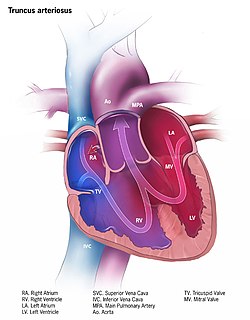Persistent truncus arteriosus

Editor-In-Chief: Prab R Tumpati, MD
Obesity, Sleep & Internal medicine
Founder, WikiMD Wellnesspedia &
W8MD medical weight loss NYC and sleep center NYC
| Persistent truncus arteriosus | |
|---|---|

| |
| Synonyms | Truncus arteriosus communis |
| Pronounce | N/A |
| Specialty | N/A |
| Symptoms | Cyanosis, heart failure, dyspnea, tachypnea |
| Complications | Pulmonary hypertension, heart failure |
| Onset | Neonatal |
| Duration | Lifelong without treatment |
| Types | N/A |
| Causes | Congenital heart defect |
| Risks | Genetic disorders, maternal diabetes, rubella infection during pregnancy |
| Diagnosis | Echocardiogram, chest X-ray, cardiac catheterization |
| Differential diagnosis | Tetralogy of Fallot, transposition of the great arteries |
| Prevention | N/A |
| Treatment | Surgical repair, medications for heart failure |
| Medication | N/A |
| Prognosis | Poor without treatment, improved with surgical intervention |
| Frequency | Rare, approximately 1 in 10,000 live births |
| Deaths | High mortality without treatment |


Persistent truncus arteriosus (PTA) is a rare form of congenital heart disease that presents at birth. In this condition, instead of having separate vessels to carry blood from the heart to the lungs and the rest of the body, there is only one common blood vessel or truncus.
Signs and Symptoms[edit]
Infants with PTA often show signs of heart failure within the first few weeks of life. These can include rapid breathing, poor feeding, and failure to gain weight. Other symptoms may include a bluish coloration of the skin and lips (cyanosis), fatigue, and poor circulation.
Causes[edit]
PTA is caused by a defect in the development of the heart during the first 8 weeks of pregnancy. The exact cause is unknown, but it is thought to involve a combination of genetic and environmental factors.
Diagnosis[edit]
Diagnosis of PTA is usually made shortly after birth, based on the infant's symptoms and a physical examination. This can be confirmed by echocardiography, which can show the single vessel coming out of the heart, and other associated heart defects.
Treatment[edit]
Treatment for PTA involves surgery to separate the single large vessel into two separate vessels, one for the lungs (pulmonary artery) and one for the body (aorta). This is usually done within the first few weeks of life. Medications may also be used to help manage symptoms before surgery.
Prognosis[edit]
With early diagnosis and treatment, the prognosis for children with PTA is generally good. However, they will need lifelong follow-up care with a cardiologist to monitor their heart function and manage any complications.
See Also[edit]
Ad. Transform your life with W8MD's Budget GLP-1 injections from $75


W8MD offers a medical weight loss program to lose weight in Philadelphia. Our physician-supervised medical weight loss provides:
- Weight loss injections in NYC (generic and brand names):
- Zepbound / Mounjaro, Wegovy / Ozempic, Saxenda
- Most insurances accepted or discounted self-pay rates. We will obtain insurance prior authorizations if needed.
- Generic GLP1 weight loss injections from $75 for the starting dose.
- Also offer prescription weight loss medications including Phentermine, Qsymia, Diethylpropion, Contrave etc.
NYC weight loss doctor appointmentsNYC weight loss doctor appointments
Start your NYC weight loss journey today at our NYC medical weight loss and Philadelphia medical weight loss clinics.
- Call 718-946-5500 to lose weight in NYC or for medical weight loss in Philadelphia 215-676-2334.
- Tags:NYC medical weight loss, Philadelphia lose weight Zepbound NYC, Budget GLP1 weight loss injections, Wegovy Philadelphia, Wegovy NYC, Philadelphia medical weight loss, Brookly weight loss and Wegovy NYC
|
WikiMD's Wellness Encyclopedia |
| Let Food Be Thy Medicine Medicine Thy Food - Hippocrates |
Medical Disclaimer: WikiMD is not a substitute for professional medical advice. The information on WikiMD is provided as an information resource only, may be incorrect, outdated or misleading, and is not to be used or relied on for any diagnostic or treatment purposes. Please consult your health care provider before making any healthcare decisions or for guidance about a specific medical condition. WikiMD expressly disclaims responsibility, and shall have no liability, for any damages, loss, injury, or liability whatsoever suffered as a result of your reliance on the information contained in this site. By visiting this site you agree to the foregoing terms and conditions, which may from time to time be changed or supplemented by WikiMD. If you do not agree to the foregoing terms and conditions, you should not enter or use this site. See full disclaimer.
Credits:Most images are courtesy of Wikimedia commons, and templates, categories Wikipedia, licensed under CC BY SA or similar.
Translate this page: - East Asian
中文,
日本,
한국어,
South Asian
हिन्दी,
தமிழ்,
తెలుగు,
Urdu,
ಕನ್ನಡ,
Southeast Asian
Indonesian,
Vietnamese,
Thai,
မြန်မာဘာသာ,
বাংলা
European
español,
Deutsch,
français,
Greek,
português do Brasil,
polski,
română,
русский,
Nederlands,
norsk,
svenska,
suomi,
Italian
Middle Eastern & African
عربى,
Turkish,
Persian,
Hebrew,
Afrikaans,
isiZulu,
Kiswahili,
Other
Bulgarian,
Hungarian,
Czech,
Swedish,
മലയാളം,
मराठी,
ਪੰਜਾਬੀ,
ગુજરાતી,
Portuguese,
Ukrainian


